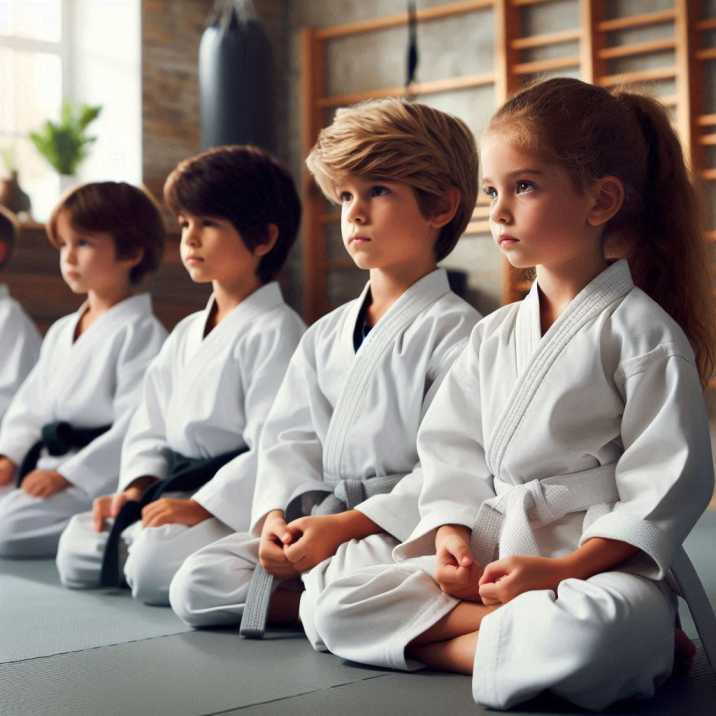Scientific martial arts are modern training systems that combine traditional martial arts techniques with scientific principles to enhance physical and mental performance. These programs focus on improving focus, discipline, and cognitive abilities, making them beneficial for children and adults alike.

Introduction
Table of Contents
Have you ever heard of scientific martial arts? They sound like something from a superhero movie, right? But they are real, exciting, and super helpful for your brain and body. These martial arts use science, logic, and strategy—not just punches and kicks—to teach people how to defend themselves, stay healthy, and become more focused in life.
In this article, we’ll explore what makes these martial arts “scientific,” how they work, and why they are great for kids like you. Whether you’re trying to do better in school or just want to have fun while staying fit, scientific martial arts could be your new favorite activity.
What Makes a Martial Art “Scientific”?
A scientific martial art is a type of martial art that uses:
1. Physics (like motion and balance)
Physics is the science of how things move. In martial arts, students learn how to use their body weight, speed, and direction to make their moves stronger. For example, when you punch or kick, physics helps you understand how to move your body to hit with more power. Balance is also important—if you don’t have it, you can fall easily. Scientific martial arts teach you how to stay stable and move smoothly, just like a dancer or gymnast.
2. Biology (how the human body works)
Biology helps martial artists understand muscles, bones, and how the body works. Knowing which joints are weak or strong helps you defend yourself better. For example, Brazilian Jiu-Jitsu uses joint locks that take advantage of how elbows and shoulders bend. It also teaches how to breathe properly and avoid getting tired too fast. Understanding your body helps you use it safely and smartly during training.
3. Psychology (understanding how people think and react)
Psychology is the study of the mind and behavior. In martial arts, it helps you stay calm, read your opponent, and make fast decisions. You learn how to stay focused even when you’re nervous or excited. Martial artists also train to control fear, anger, or surprise so they can react wisely, not wildly. This also helps in real life—like staying calm during a test or when facing a tough problem.
4. Mathematics (timing, angles, distance)
Math helps martial artists know the best time and place to move. Timing means knowing when to block or strike. Angles are important too—attacking from the side or at a certain angle can make a move stronger or safer. Distance helps you stay just far enough from your opponent to stay safe, but close enough to act fast. Scientific martial arts teach you to see patterns and use smart movement instead of just fast movement.
These martial arts aren’t just about being strong—they’re about being smart and efficient. You don’t need to be the biggest kid in class. You just need to know how to use techniques that work with your body and mind.
Examples of Scientific Martial Arts
Let’s look at some well-known scientific martial arts and what makes them unique.
1. Brazilian Jiu-Jitsu (BJJ)
Brazilian Jiu-Jitsu focuses on fighting on the ground using locks and holds. It teaches you how to use leverage and angles to control someone, even if they’re bigger than you. Instead of using strength, it’s all about being smart with how you move your body. It’s like solving a puzzle using your opponent’s energy against them. That’s why BJJ is often called a “thinking person’s martial art.” It’s based on biomechanics, the science of how the body moves.
2. Jeet Kune Do (JKD)
Jeet Kune Do was created by famous martial artist Bruce Lee. He believed fighting should be simple, direct, and efficient. Bruce Lee used physics, philosophy, and psychology to design JKD. This martial art teaches students to react quickly and adapt to any situation. Instead of memorizing hundreds of moves, it focuses on smart thinking and real-life strategy. JKD is sometimes called the “science of street fighting.”
3. Krav Maga
Krav Maga was made for the Israeli military, and it’s great for real-life self-defense. It teaches fast, simple moves to stop danger quickly. This martial art uses your natural reflexes—like how you move when something surprises you. It also teaches how to stay calm and make fast choices under stress. Body mechanics and quick thinking make it very scientific and practical. It’s designed to keep you safe in the real world.
4. Systema (Russian Martial Art)
Systema is a unique martial art from Russia. It focuses on relaxation, breathing, and natural movement. Instead of stiff techniques, it teaches you to move like water—fluid and smooth. Systema studies the nervous system and human anatomy to train your body to stay calm, even in a fight. It also teaches you how to stay healthy and avoid injury. It’s less about fighting hard and more about moving smart.
5. Boxing
Boxing is all about using your fists and feet to move fast and strike smart. It might look simple, but it’s full of science. Boxers use timing, distance, and angles to land punches while staying safe. They also learn about kinetics, which is the science of force and motion. A well-timed punch with good footwork can do more than just swinging wildly. Boxing shows how brainpower and timing matter as much as strength.
Why Scientific Martial Arts Help in Real Life
Improved Focus in School
Learning a scientific martial art means paying close attention to every move you make. You have to stay calm, focused, and think clearly, even when you’re tired or under pressure. These skills carry over into school—helping you concentrate better in class. Whether you’re reading a book or solving a math problem, martial arts training helps your brain stay sharp. Students who train often do better on tests and homework.
Better Discipline and Behavior
Martial arts classes are built around respect, routine, and responsibility. You learn to bow to your teacher, follow instructions, and practice with a partner safely. This teaches you discipline, which means doing the right thing, even when no one is watching. You also build good manners, like listening carefully and waiting your turn. These habits help you behave better at home and in school.
Health and Fitness
Practicing martial arts is great exercise! You run, jump, stretch, and use your whole body. This helps you get stronger, faster, and more flexible. When your body is healthy, your brain works better too. Martial arts also teach you how to breathe deeply and move safely, which helps prevent injuries. It’s a fun way to stay fit and feel full of energy.
Confidence and Safety
When you know how to defend yourself using smart, scientific moves, you feel more confident. Martial arts give you the tools to stay safe without needing to fight. You learn how to stay calm in scary situations and make smart choices. Confidence helps you speak up, try new things, and believe in yourself. It’s not about being a bully—it’s about being brave.
Scientific Concepts in Martial Arts
| Scientific Field | How It’s Used in Martial Arts |
|---|---|
| Physics | Power generation, motion, balance |
| Biology | Joint movement, muscle control |
| Mathematics | Timing, angles, distance |
| Psychology | Reading an opponent, focus |
| Biomechanics | Leverage and posture |
How Scientific Martial Arts Are Taught
Step-by-Step Learning
In scientific martial arts, you don’t learn everything at once. Instructors (also called sensei or coaches) teach you step by step—starting with easy moves, then moving to harder ones. It’s like learning math—you master adding before you learn fractions! This helps your brain understand and remember what you’re doing. Each lesson builds on the last, so you keep getting better over time.
Real-Life Scenarios
Martial arts teach you how to react in real-life situations. For example, if someone grabs your wrist or tries to push you, you’ll know what to do. Instead of panicking, you stay calm and use smart moves. These lessons help you feel safer and more prepared in the real world. You learn how to protect yourself and avoid danger, not just fight.
Feedback and Corrections
Your instructor watches you closely and gives feedback to help you improve. They may say, “Bend your knees more,” or “Keep your hands up.” This is just like when your school teacher shows you how to fix a math problem. Getting corrections helps you learn the right way and avoid mistakes. It’s how you grow into a better, more skilled martial artist.
Training Builds Life Skills
Concentration
When you’re practicing martial arts, you have to pay close attention to every move and direction. This trains your brain to stay focused, even when things get tricky. That same focus helps you do better in school, especially during reading, writing, and tests.
Goal-Setting
In martial arts, you work toward earning belts or certificates by learning new skills. This teaches you how to set goals, work hard, and never give up. Reaching a goal—like earning a new belt—feels exciting and builds self-confidence.
Problem-Solving
Every move in martial arts is like a fun puzzle. You have to think: “What’s the best way to block this?” or “How can I move without getting off balance?” This kind of smart thinking helps you solve real-life problems too—at home, in school, or with friends.
Patience and Respect
Martial arts teach you to stay calm, quiet, and respectful, even when you’re excited or nervous. You learn to wait your turn, listen carefully, and treat your teachers and partners kindly. These lessons help you become a better friend and student.

Fun Facts and Stats
- 93% of parents say martial arts help kids with focus and behavior.
- Children who practice martial arts score better on attention tests.
- Scientific martial arts are becoming more popular in schools and after-school programs.
Conclusion
Scientific martial arts are more than just kicks and punches. They combine body, brain, and discipline to help kids become stronger, smarter, and more focused. Whether it’s Brazilian Jiu-Jitsu, Jeet Kune Do, or Krav Maga, these arts are built on science and logic.
For kids in the US and around the world, training in a scientific martial art can lead to better grades, more confidence, and lifelong healthy habits. So the next time someone asks if martial arts are just for fighting, you can say, “Nope! They’re for thinking, growing, and leading, too.”
5 FAQs About Scientific Martial Arts
1. What does “scientific martial arts” mean?
It means using science like physics, biology, and psychology to make martial arts smarter and more effective.
2. Can kids learn scientific martial arts?
Yes! Many scientific martial arts are perfect for kids and help with focus, discipline, and fitness.
3. Is Brazilian Jiu-Jitsu a scientific martial art?
Yes, because it uses leverage and technique instead of strength, which makes it smart and scientific.
4. How do scientific martial arts help in school?
They teach focus, discipline, and calm thinking—all helpful for studying and learning.
5. Do scientific martial arts help with self-defense?
Absolutely. They teach you to protect yourself using smart moves, not just strength.



